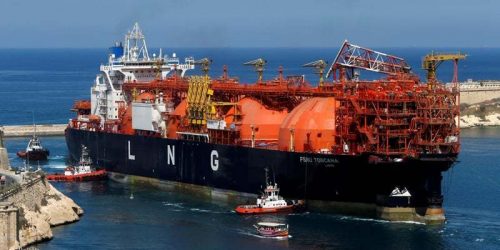As another major supply disruption of liquefied natural gas (LNG) looms large, the government is looking for legally safe and commercially viable alternatives to allow continuation of ‘larger replacement regasification terminal’ currently operating in Port Qasim as a fait accompli to avoid major power shortfalls and have greater gas availability during winters.
Engro Elengy Terminal Limited (EETL) has told the government entities that due to exchange of its Floating Storage and Regasification Unit (FSRU), there will be complete disruption of regasification process for 60 to 90 hours between Sept 7 and 11. EETL had taken out its original FSRU, Exquisite, on June 28-29 for unavoidable maintenance and replaced it with a relatively larger ‘replacement terminal’, Sequoia, causing LNG disruption for a few days.
The EETL has been asking the government and Sui Southern Gas Company Limited (SSGCL) for the last few years to allow a larger ship to replace Exquisite to enhance its regasification capacity, with additional capacity for private sales to other LNG consumers.
Because of ongoing investigations by the National Accountability Bureau (NAB) and related cases in courts on account of capacity enhancement from 400 to 600 million cubic feet per day, the SSGCL and petroleum division had been resisting such a permission that is not part of the original service or supply agreements.
A major setback to gas supplies twice and that too in summer results in poor public image of a political government, an official said.
The situation on ground, however, is that EETL has given two options on an immediate basis.
“Complete regasification stoppage for 60 hours (causing 1.6 billion cubic feet gas shortage)” in case the Exquisite Vessel comes back LNG laden or 91 hours (2.445 BCF shortage) in case it returns unladen.
Sui Northern Gas Pipelines Limited (SNGPL) has already raised ‘red flags’ that it had firm downstream agreements with three major LNG-based power plants of about 4,000mw as per pre-approved Annual Delivery Plan (ADP) based on back to back consultations with all supply chain partners, including planned terminal outages.
Drop in RLNG to these power plants other than ADP are legally treated as non-supply and involve heavy capacity payments and liquidity damages.
On top of that, two gas fields of about 100mmcfd would also be going on annual turn around in the second-third week of September. The alternative fuel — furnace oil and diesel — is too expensive and attracts public criticism during public hearings on fuel cost adjustments by the power regulator. But on the other side, the liquidity damages because of non-supply of LNG pile up on the two gas companies — SSGCL and SNGPL.
A senior official said the government needed additional LNG terminal capacity to meet higher demand in winters that exist with the two terminals but not contracted. In this regard, about 150mmcfd capacity is available in the second terminal of Pakistan Gasport and another 150-180mmcfd in case of Engro’s replacement vessel Sequoia. However, it drops to 60mmcfd in case of Engro’s original Exquisite terminal.
“We want to tap this entire available capacity of about 300mmcfd, preferably in the public sector but also in the private sector,” he said.
The priority, however, is to secure this additional capacity that is in no way disadvantageous to the government, its entities or the public at large, and is “legally permissible, commercially viable and not restricted by any court order”. That means the re-gasification tariff should go down.





